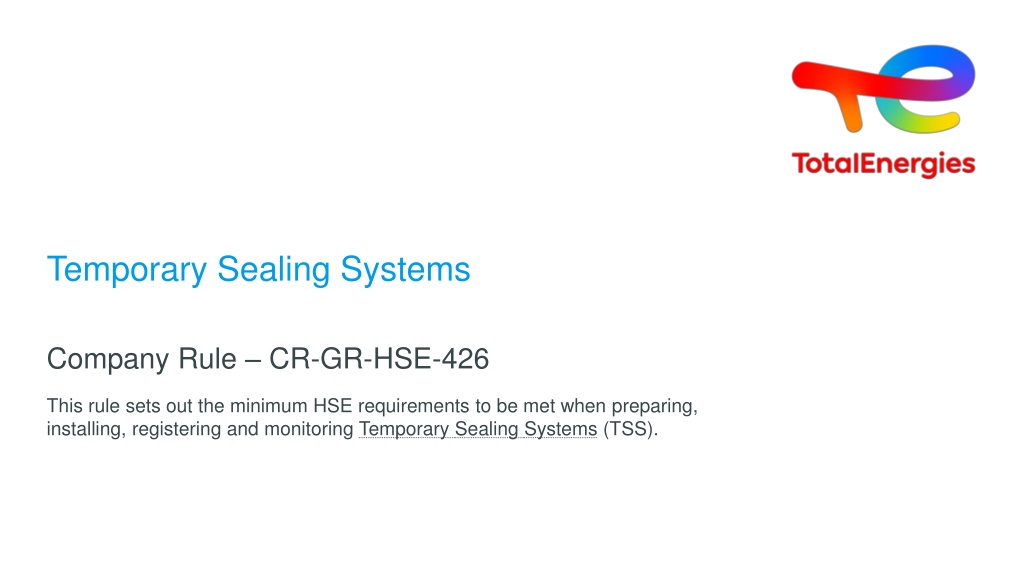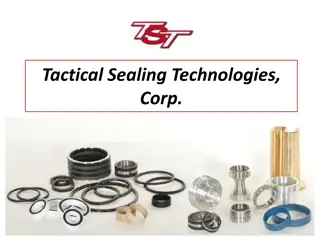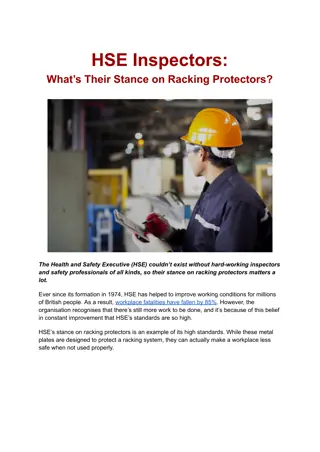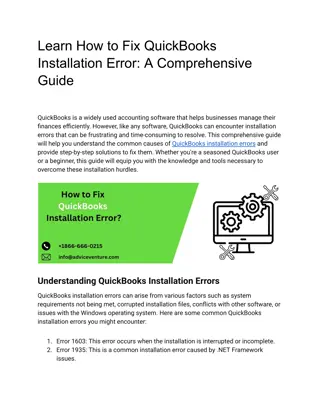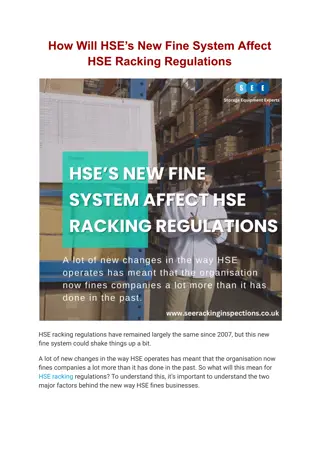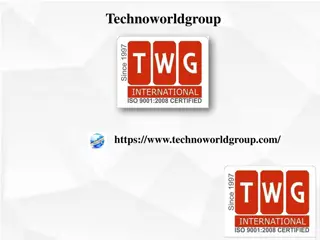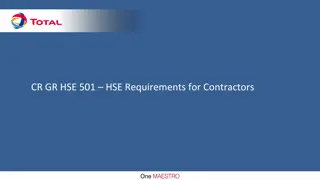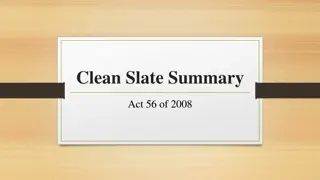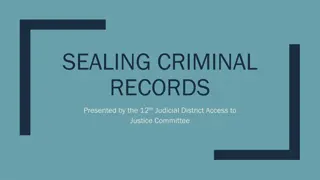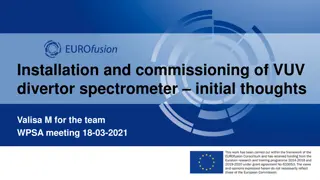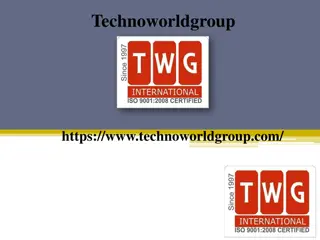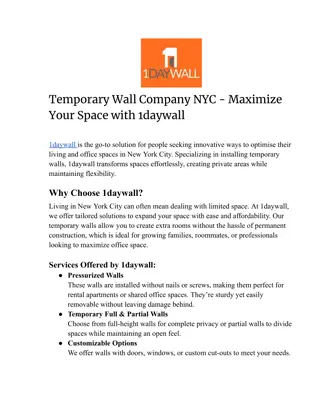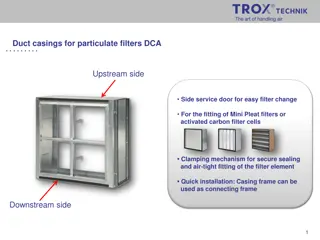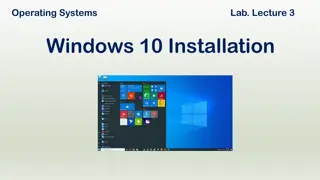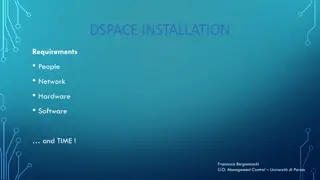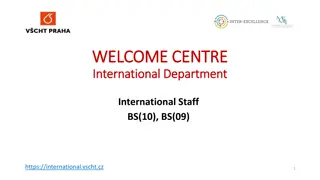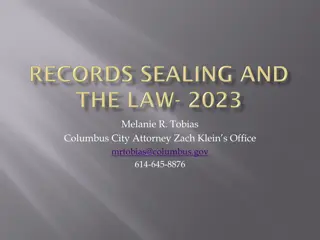Minimum HSE Requirements for Temporary Sealing Systems (TSS) Installation
This rule, CR-GR-HSE-426, outlines the essential HSE requirements for preparing, installing, registering, and monitoring Temporary Sealing Systems (TSS). It focuses on safety measures for technicians using TSS and ensuring the integrity of temporary repairs. The rule covers various TSS types such as mechanical clamps, composite repair systems, and collars on piping, within a structured process that includes risk analysis, decision-making, installation, monitoring, and auditing.
Download Presentation

Please find below an Image/Link to download the presentation.
The content on the website is provided AS IS for your information and personal use only. It may not be sold, licensed, or shared on other websites without obtaining consent from the author. Download presentation by click this link. If you encounter any issues during the download, it is possible that the publisher has removed the file from their server.
E N D
Presentation Transcript
Temporary Sealing Systems Company Rule CR-GR-HSE-426 This rule sets out the minimum HSE requirements to be met when preparing, installing, registering and monitoring Temporary Sealing Systems (TSS).
CR-GR-HSE-426 Safety of technicians (Antwerp REX) when using Temporary Sealing System (TSS) and integrity of the temporary repair (other REX). Extend REG-GR-SEC-024 MAJOR REX from clamps to any kind of temporary sealing systems Context HSE Requirements for Temporary Sealing Systems (TSS) Rewriting from REG-GR-SEC standard to new CR-GR HSE standard Object All TSS including, but not limited to Mechanical clamps with sealant injection for equipment piping, flanges, piping Composite repair systems for equipment piping and piping Collars on piping (standard commercial bolted systems) All Businesses of the Company Scope Exclusions Weld repairs. 1 rule (REG-GR-SEC-024). Impact on CR-MS-HSEQ 202 (Operations and works at risk 7. temporary leak repair) Replace Dates Application : 6 month after validation/publication CR-GR-HSE-426 2
Extension of scope with same requirements on clamp Clamp with injected sealant for equipment pipes, flanges and pipes REG-GR- SEC-024 CR-GR- HSE-426 Composite repair systems for equipments pipes and pipes Collars on piping (standard commercial bolted systems) CR-GR-HSE-426 3
Rule Structure : 10 themes, 16 requirements 16 Requirements Process Organization 1- Procedure, 2- Approved company and authorized staff 1 Prerequisite for TSS* 3- Prerequisite for the installation of a TSS 2 4- Compiling the intervention dossier , 5- Technical feasibility study and choice , 6- Preliminary risk analysis Internal risk analysis 3 External risk analysis 7- External risk analysis, 8- External company Dossier 4 Intervention decision 9-Intervention Decision 5 Installing TSS* 10- Identification, registration, 11- Work acceptance 6 Preparation of permanent repair 12- Preparation and scheduling of the permanent repairs 7 Online monitoring TSS* 13- Monitoring in operation, 14 Additional intervention for a TSS 8 TSS* removal 15- Expertise during removal 9 10 Internal audit process 16- Internal audit * TSS : Temporary Sealing System CR-GR-HSE-426 4
Summary of requirement improvements 16 Requirements Modifications versus REG-SEC-024 No change but scope extension 1- Procedure, 2- Approved company and authorized staff No change but scope extension 3- Prerequisite for the installation of a TSS Integration of recent REX learnings in Appendix 1, Choice of TSS type added due to scope extension Need to differentiate composite repair and bolted system for isolated equipment 4- Compiling the intervention dossier , 5- Technical feasibility study and choice , 6- Preliminary risk analysis Need to differentiate composite repair and bolted system for isolated equipment No change but scope extension 7- External risk analysis, 8- External company Dossier No change but scope extension 9- Intervention Decision Unique reference added and details of register No change but scope extension 10- Identification, registration, 11- Work acceptance No change but scope extension 12- Preparation and scheduling of the permanent repairs No change but scope extension No change but scope extension 13- Monitoring in operation, 14- Additional intervention for a TSS Required now only in case of issues for example due to sealings problems or when the corrosion mechanism is not well established 15- Expertise during removal 16- Internal audit New requirement * TSS : Temporary Sealing System CR-GR-HSE-426 5
Modification for branches and added value RC : limited impact due to existing CR (CR-RC-MIT 009). - Each site has already a procedure . Needs to be updated. Added value : some improvement and recent REX integrated EP : several technical GS covering composite repair but no CR. - Processus needs to be formalized Added value : Today no specific HSE rules but different technical GS on the topic with some gaps. Benefit from lessons learnt coming from recent REX mainly from RC GRP : limited impact Added value : REX mainly from RC MS : limited impact due to existing CR (CR-MS-HSEQ 202) Added value : REX mainly from RC CR-GR-HSE-426 6
Thanks CR-GR-HSE-426 7
Annexes CR-GR-HSE-426 8
Requirements {Requirement 3.1.1: Temporary Sealing Systems procedure The process for temporary sealing systems is set out in a documented procedure incorporating at least the requirements of this rule. It specifies the roles and responsibilities and the approval levels for each step in the process based on the risks. No change (already in REG-GR-SEC-024) but scope extension {Requirement 3.1.2: Approved company and authorized staff Only contractors selected and approved in advance by the entity or subsidiary for this type of intervention are retained. The contractor provides the entity or subsidiary with a list of qualified intervention staff. No change (already in REG-GR-SEC-024) but scope extension CR-GR-HSE-426 9
Requirements Requirement 3.2.1: Prerequisite for the installation of a temporary sealing system Permanent repair, preferred to the installation of a temporary sealing system, has been considered and evaluated. In most cases, the installation of a temporary sealing system entails high risks, so it is deemed exceptional and subject to special measures. If installation of temporary sealing system is necessary, it will be initiated only when following conditions have been checked: The repair area is sufficiently accessible and can be easily evacuated, making it safe for an intervention. The risks of auto-ignition, flammability, explosion in contact with a hot point, toxicity and/or burning, pollution and mechanical damage around the leak are acceptable with the implementation of risk control measures. Step already in REG-GR-SEC-024 but scope extension Requirement 3.3.1: Compiling the intervention dossier The entity or subsidiary gathers all necessary information and prepares the intervention dossier for the installation of the temporary sealing system. The minimum contents of this dossier are stated in Appendix 1. No change (already in REG-GR-SEC-024). Integration of recent REX learnings in Appendix 1 CR-GR-HSE-426 10
Requirements Requirement 3.3.2: Technical feasibility study and choice of temporary sealing system type The entity or subsidiary studies the technical feasibility of installing the temporary sealing system and decides on the most appropriate type of temporary sealing system. This choice is based on the applicable regulations, guides and technical specifications taking account of the damage mechanism, as well as the product type, the operating conditions and the required service life of the equipment. Technical feasibility already in REG-GR-SEC-024. Choice of TSS type added due to scope extension Requirement 3.3.3: Preliminary risk analysis A preliminary risk analysis based on the checklist in appendix 1 is formalized and validated by a multidisciplinary team. Based on this analysis the decision can be taken on whether to conduct the temporary sealing system study. For composite repair systems or commercial bolted systems installed on isolated equipment risk analysis can be realized during dedicated job risk analysis of permit to work on basis of typical risk analysis per type of service Step already in REG-GR-SEC-024. Need to differentiate for composite repair and commercial bolted system on isolated equipment for simplification (pilot feedback) CR-GR-HSE-426 11
Requirements Requirement 3.3.4: Risk analysis and acceptance by the external company The entity or subsidiary asks the contractor to conduct its own risk analysis based on the intervention dossier, the results of its investigations on site (site visit and discussion with at least the person in charge of the dossier) and the conclusions of its feasibility studies. The result of the risk analysis by the contractor determines whether it accepts the contract to install the temporary sealing system. This requirement is not mandatory for composite repair systems or commercial bolted system installed on isolated equipment No change (already in REG-GR-SEC-024). Need to differentiate for composite repair and commercial bolted system on isolated equipment for simplification (pilot feedback) Requirement 3.3.5: External company dossier If it accepts the contract, the contractor is asked to provide a preparatory dossier including at least the points stated in Appendix 2. } No change (already in REG-GR-SEC-024) CR-GR-HSE-426 12
Requirements Requirement 3.4.1: Intervention decision The intervention decision is based on the (internal and external) risk analyses and formally approved by the signing of the intervention dossier by the persons in charge as designated in the temporary sealing system procedure at the entity or the subsidiary and by the contractor. l No change (already in REG-GR-SEC-024) Requirement 3.5.1: Identification, registration and monitoring A unique temporary sealing system reference number is affixed to the temporary sealing system in the field and on the plan. Every temporary sealing system arrangements set out in the procedure of the entity or subsidiary. installation or additional intervention must be recorded and tracked in accordance with the A comprehensive register for monitoring temporary sealing systems is available on site. This comprises of: - the unique reference for each temporary sealing system - the temporary sealing system type - the date on which it was taken into service - the dates of any additional interventions - the scheduled and actual completion date of removal of the temporary sealing system } Already in REG-GR-SEC-024. Unique reference added and details of register (Antwerp REX post accident). No requirements on permit to work already in CR-GR-HSE-402 (permit to work) .Repair by clamp defined as high-risk activity if done online CR-GR-HSE-426 13
Requirements Requirement 3.5.2: Acceptance of work An intervention report must be drawn up by the contractor (see appendix 2) and the entity or subsidiary, after work is completed and formally accepted on the site of work. These reports are grouped together in the intervention dossier. } No change (already in REG-GR-SEC-024) Requirement 3.6.1: Preparation and scheduling of the permanent repairs Alongside the installation of the temporary sealing systems, the preparations are started to ensure that the necessary equipment is available for the permanent repair. The permanent repair should be done at the earliest opportunity (scheduled shutdown or turnaround or unscheduled shutdown where the equipment is cleared for maintenance) after the installation of the temporary sealing systems without exceeding the initial deadline as set. No change (already in REG-GR-SEC-024) CR-GR-HSE-426 14
Requirements Requirement 3.7.1: Monitoring in operation The specific monitoring arrangements (operator round, inspections, detectors, specific process conditions etc.) are implemented by the competent entities of the site, as set out in the procedure of the entity or subsidiary. No change (already in REG-GR-SEC-024) Requirement 3.7.2: Additional intervention for a temporary sealing system The reasons for the additional intervention must be identified, and the number of additional interventions already completed taken into account along with how the leak flow rate is changing. A new risk analysis is conducted as set out in appendix 1. Furthermore, in case of mechanical clamps with sealant injection, after three reinjections, every subsequent reinjection must be formally approved by the management of the entity or subsidiary. No change (already in REG-GR-SEC-024) CR-GR-HSE-426 15
Requirements Requirement 3.8.1: Expertise during removal When a temporary sealing system is removed, in case of sealing difficulties or when corrosion mechanism is not well established, the equipment and surrounding area are visually inspected in the presence of the designated representatives of the entity or subsidiary operating the site to make observations on the damage mechanism of the equipment and the condition of the temporary sealing system. } Requirement already in REG-GR-SEC-024. Required now only in case of issue Requirement 3.9.1: Temporary sealing systems internal process audit An audit programme is set up at the entity or subsidiary to verify the application of the temporary sealing systems procedure. At the end of the audit, an action plan is issued and the implementation is checked in periodical reviews until all instances of non-compliance have been dealt with appropriately. New requirement CR-GR-HSE-426 16
Documents used Branche R f rence Titre REG-GR-SEC-024 REX MAJOR REX Requirements for sealing leaks online Groupe GS-EP-PLR-310 Pipeline composite repair systems wet tape systems according to ISO24817 E&P GS-EP-PVV-711 Composite repairs for metallic pipeworks and pressure vessels GS-EP-EXP-311 Plant integrity Minimum inspections requirements (4.5.2.6 temporary repairs) GM-EP-COR-054 Corrosion (10.1 Composite temporary repairs) CR MS HSEQ 202 High-risk operations and works ( 7. Temporary sealing of leaks) M&S CR RC MIT 009 Management of temporary leak repair systems. (rule co-signed by HSE) R&C GM-RC-MIT 520 Guide for the Design and Manufacture of mechanical clamps for on line repair GM-RC-MIT-225 Accreditation of contracting companies in charge of on-line leak sealing works GRP CR-GR-HSE-426 17
WORKING GROUP Domain Owner (DO) : Pol HOORELBEKE Main contributors during reviews : Technical Authority (TA) : Eric VERDONCK Antwerp refinery TEP Angola TEP Congo US RC Sites Participants: C. Champigny HSE/MMR/REF H. Rodriguez EP/DSO/IP/EXP/MIN/INS J. Donadey RC/IND/EXM/EXP J. Negre HSE/EP/SHI/ASSD L. Cristini MS/SMR/SLP/TP/BE/TEC Company TEAM RC/IND/EXM F. CLEMENT EP/DSO/IP/TEC/PVV I. BOUGET CR-GR-HSE-426 18
Avertissement - Proprit intellectuelle D finition TotalEnergies / Compagnie Les entit s dans lesquelles TotalEnergies SE d tient directement ou indirectement une participation sont des personnes morales distinctes et autonomes. Les termes TotalEnergies , compagnie TotalEnergies et Compagnie qui figurent dans ce document sont g n riques et utilis s des fins de convenance pour d signer TotalEnergies SE et les entit s comprises dans le p rim tre de consolidation. De m me, les termes nous , nos , notre peuvent galement tre utilis s pour faire r f rence ces entit s ou leurs collaborateurs. Avertissement Cette pr sentation peut contenir des d clarations prospectives, au sens du Private Securities Litigation Reform Act de 1995, relatives la situation financi re, aux r sultats d'exploitation, aux activit s, la strat gie et aux projets de TotalEnergies, qui sont soumis des facteurs de risque et des incertitudes r sultant de changements dans, notamment, le d veloppement et l'innovation technologiques, les sources d'approvisionnement, le cadre juridique, les conditions de march , les v nements politiques ou conomiques. TotalEnergies n'assume aucune obligation de mettre jour publiquement les d clarations prospectives, que ce soit en raison de nouvelles informations, d' v nements futurs ou autres. De plus amples informations sur les facteurs susceptibles d'affecter les r sultats financiers de la Compagnie sont fournies dans les documents d pos s par TotalEnergies aupr s de l'Autorit des March s Financiers et de la US Securities and Exchange Commission. En cons quence, aucune certitude ne doit tre accord e l'exactitude ou la justesse de ces d clarations. Propri t intellectuelle Toute reproduction, publication, transmission ou plus g n ralement toute exploitation des l ments de cette pr sentation est interdite, sauf autorisation crite expresse de TotalEnergies. CR-GR-HSE-426 19
